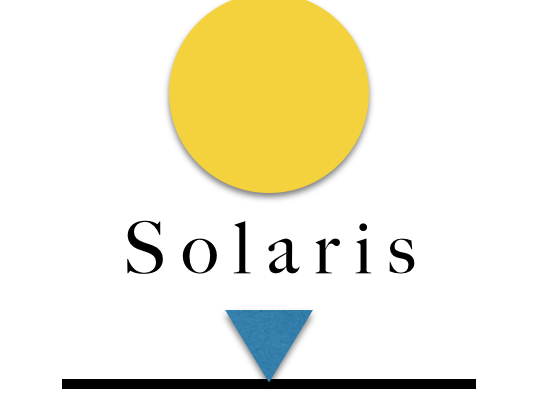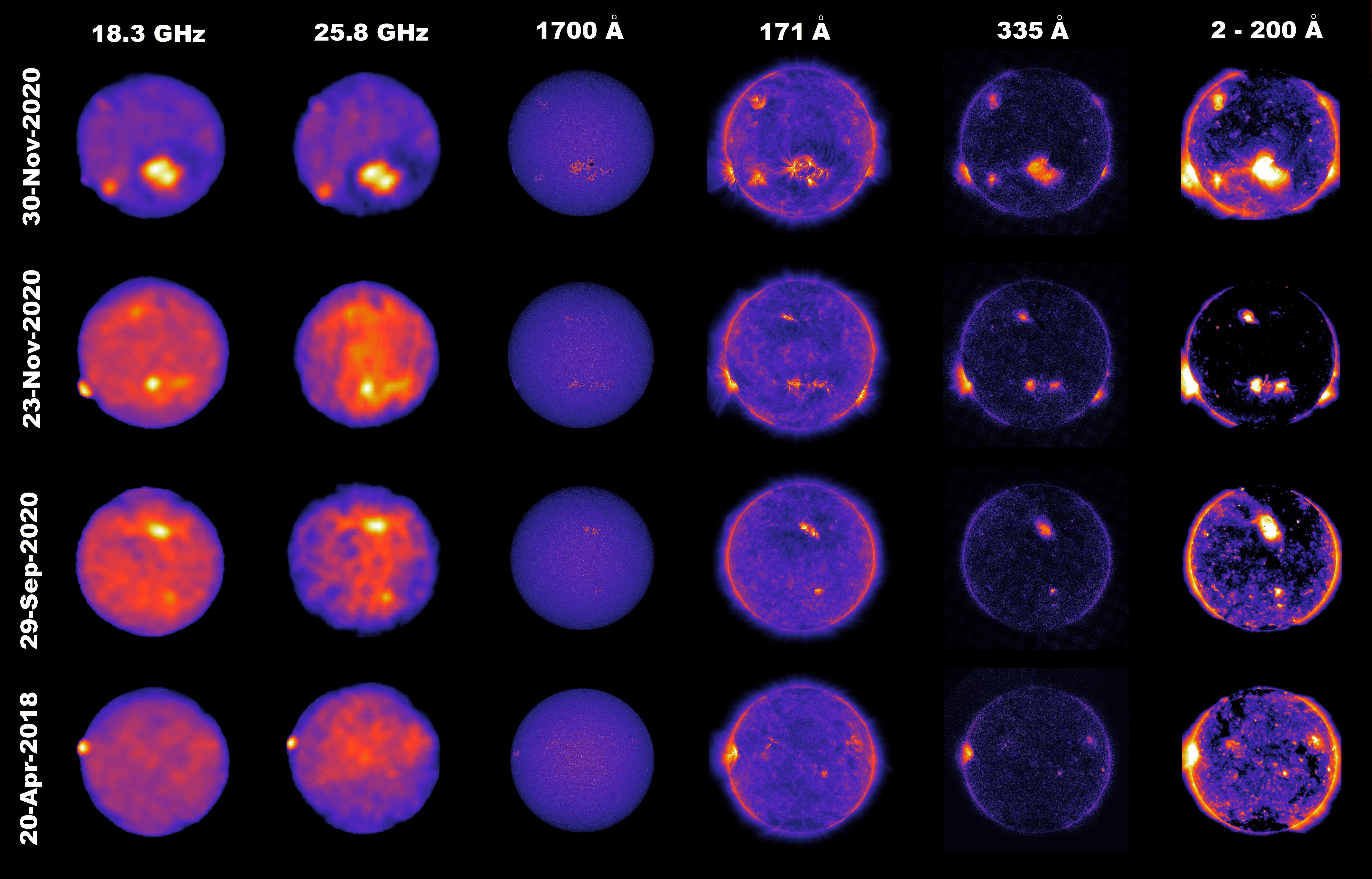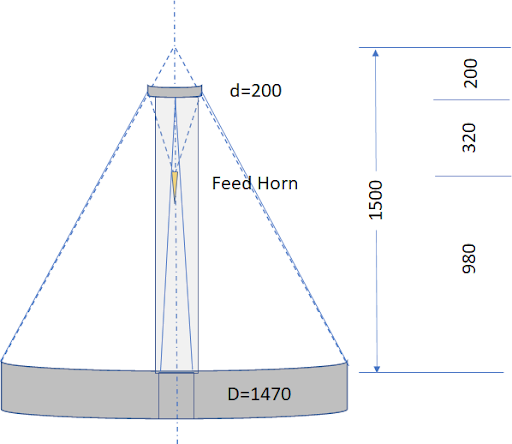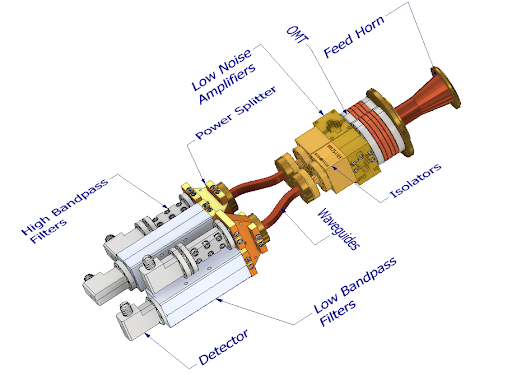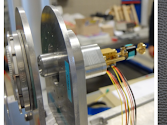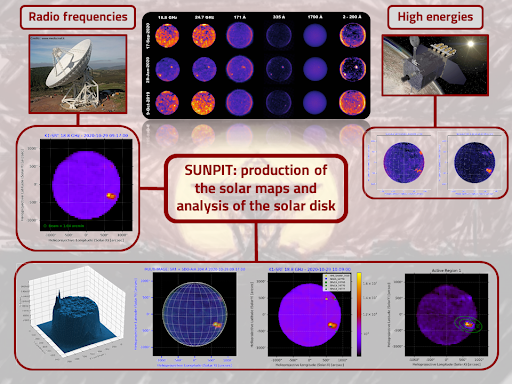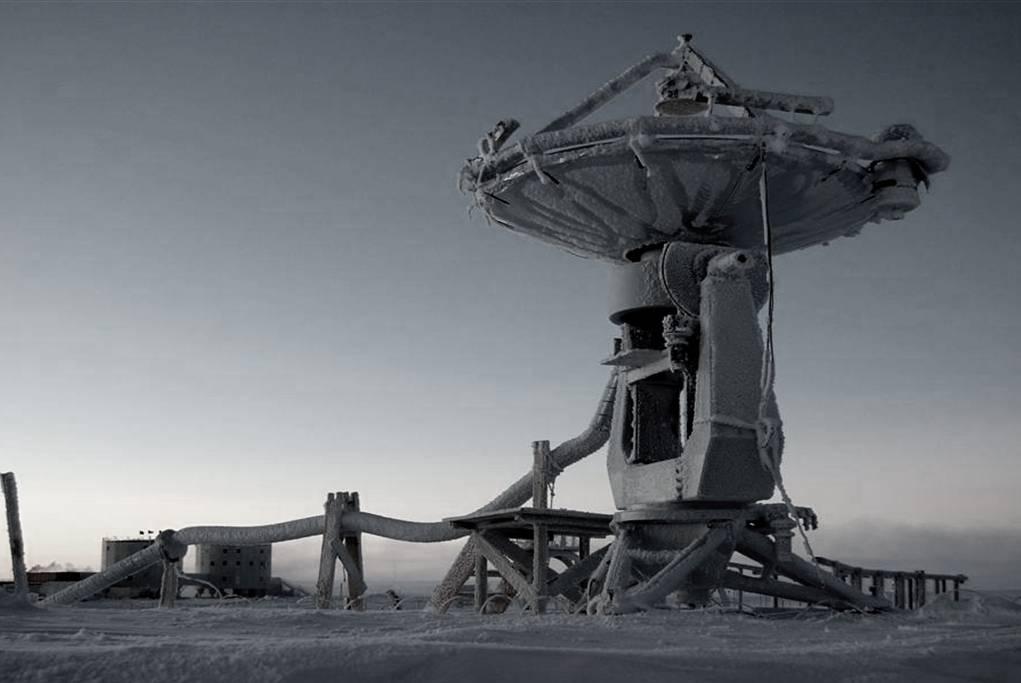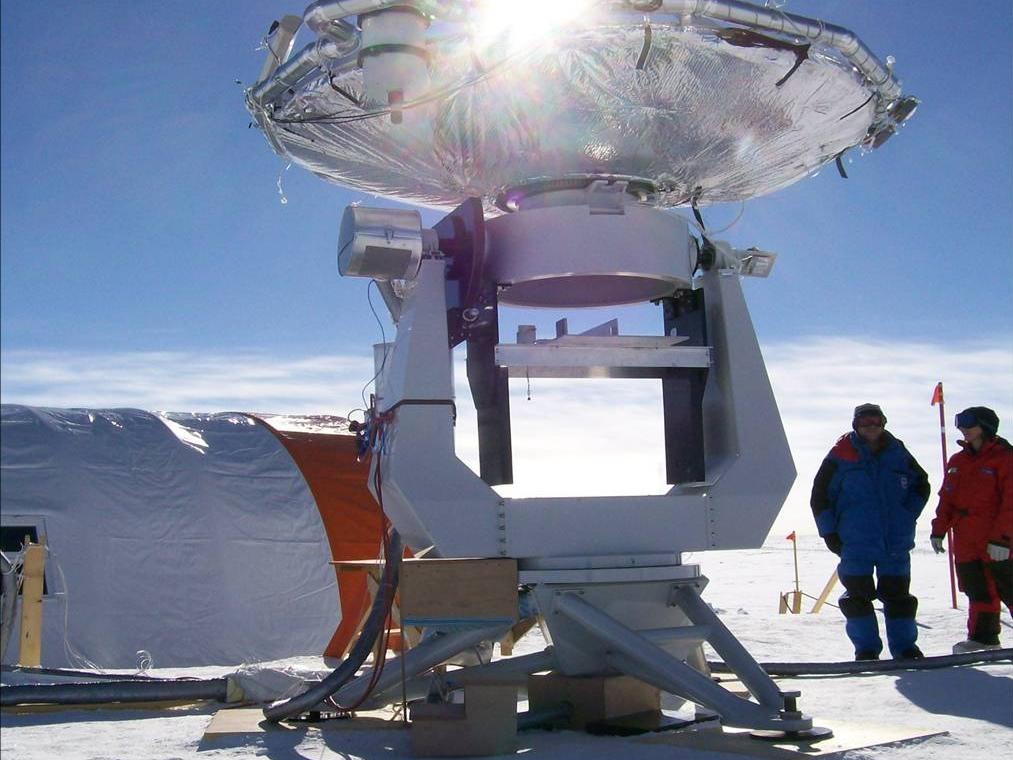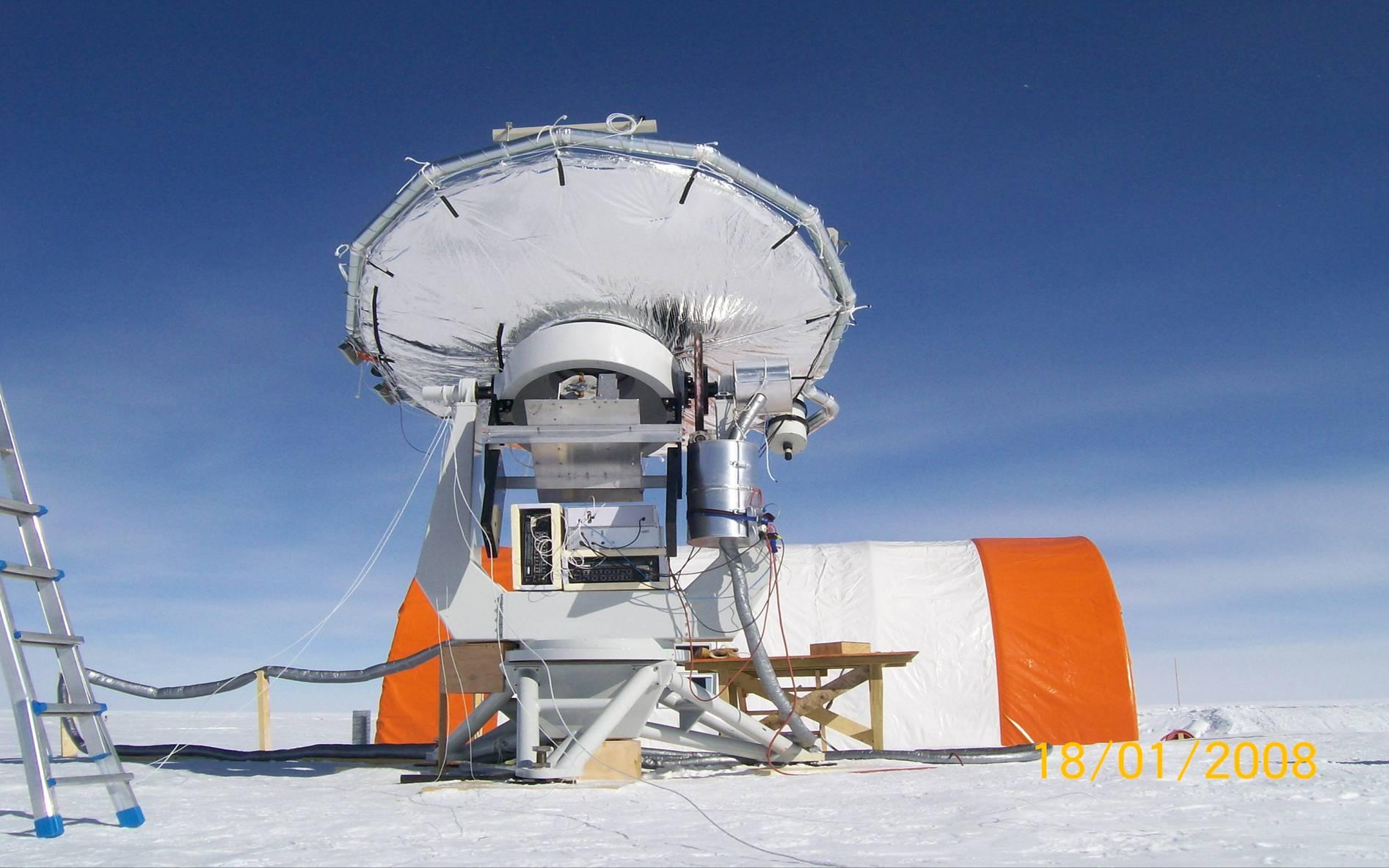- Acronimo
- OSS-13 SOLARIS
- Codice
- PNRA0000021
- Anno
- 2023
- Area di ricerca
- Universe
- Tematica specifica di ricerca
- Solar radio observations and monitoring for Astrophysics and Space Weather applications
- Regione di interesse
- Antarctica MZS & Concordia
- Sito web progetto
- https://sites.google.com/inaf.it/solaris
- PI
- Alberto Paolo Pellizzoni
- Istituzione PI
- INAF-Osservatorio Astronomico di Cagliari
- Sito web istituzionale
- https://sites.google.com/inaf.it/sundish
- Altre Istituzioni e soggetti coinvolti
- UNIMI, UNIMIB, INAF-OAS, INAF-IRA, UNIROMA3, INFN
- Consistenza del team ricerca
- Solaris Team is growing up! About 35 researcher, technologists and technicians involved so far. A relevant aspect of the Solaris action will be to raise several young scientists and technicians to guarantee further continuity to different Solaris observation sites. The opportunity to work in university departments and INAF laboratories will allow continuous formation and selection of the people who will operate in Antarctica. These opportunities will be offered paying careful attention to gender balance and exploiting the different talents of people willing to contribute to Solaris.
- Stato progetto
- In corso
- Stazioni principali usate
- Attività svolta in Italia MZS Concordia
- Il progetto
Solaris is a scientific and technological project aimed at the development of a smart Solar monitoring system at high radio frequencies based on single-dish imaging techniques. It combines the implementation of a dedicated and interchangeable 100 GHz receiver on existing small radio telescope systems (1.5/2.6m class) available in our laboratories in Milan and in Antarctica, to be adapted for Solar observations.
The Solaris Observatory is designed for operations in Antarctica, that will offer unique observing conditions (very low sky opacity and long Solar exposures) and unprecedented Solar monitoring in radio W-band. This will be achieved through state-of-the-art single-dish imaging techniques at radio frequencies, that allows to map the entire Solar disk in less than 30 min with spatial resolution of a few arcminutes. This opens for the identification and spectral analysis of Active Regions before, after and during the occurrence of Solar flares. These system features will allow Solaris to explore cutting-edge aspects of Solar Physics (e.g. chromosphere dynamic monitoring) and Space Weather applications (e.g. flare forecast).
Solaris can perform continuous Solar imaging observations nearly 20h/day during Antarctic summer exploiting the observation facility OASI existing in East Antarctica at Mario Zucchelli Station. The project mostly uses existing expertise and instrumentation yet available at the Universities and INAF laboratories of our collaboration. We intend to offer to the scientific community a very competitive tool and to young scientists a unique opportunity of professional growth in the challenging multi-disciplinary framework of Solar Physics and Space Weather science.
The Solaris observatory will be the only Solar facility offering continuous monitoring at 100 GHz, and it will be able to collect and disseminate data in synergy with the existing national and international network of Space Weather facilities.
- Immagini
-
- Motivazione, importanza della ricerca
Studying the Solar atmosphere at different wavelengths represents a major topic of current astrophysics and Space Weather. However, some radio frequency bands surprisingly lack of Solar observations, despite being relevant for models (see e.g., Shibasaki, Alissandrakis, and Pohjolainen, 2011; Nindos, 2020). Compared to the emission in other spectral ranges (e.g. the EUV), the radio one has the advantage of being understood as originating mostly from thermal bremsstrahlung in local thermodynamic equilibrium, and sporadic and variable gyro-magnetic emission in active regions (ARs; Dulk, 1985). As the opacity increases with the observing wavelength, the effective height of the involved phenomena in the Solar atmosphere moves from the temperature minimum region to the low corona. The former is visible at sub-millimeter frequencies and approached by a few instruments, e.g. ALMA (Loukitcheva, 2019), while the latter is mostly visible at meter wavelengths, reached by e.g. LOFAR (Zhang et al., 2020). On the other hand, high radio-frequency observations are generally sparse especially in the 20–200 GHz range (see e.g. Selhorst, Silva, and Costa, 2005; Gopalswamy, 2016), and the dynamic chromospheric activity lacks of continuous or frequent monitoring suitable for Space Weather. In particular, accurate measurements of the brightness temperature of the Quiet-Sun (QS) component are lacking and/or scattered above 30 GHz due to the difficulty to separate the pure QS component from the contribution of the ARs. Disentanglement and quantification of free-free and variable gyro-magnetic emission components is an open issue while studying radio ARs (see e.g. Lee, 2007; White, 2004). Significant spectral variations and/or the formation of a local maximum in the microwave/sub-mm spectrum of Solar ARs appear to be an important factor in predicting powerful flares (see e.g. Borovik, Grigoreva, and Korzhavin, 2012). Continuous radio monitoring campaigns might provide spectral index estimates for the ARs, and detect anomalous spectral variations (e.g. sudden flattening) as a signature anticipating the flaring process (Pellizzoni et al., 2022).
Single-dish techniques offer accurate calibrated images independently from the target size, free of the synthesis imaging artefacts present in interferometric observations (see Loru et al., 2019; Pellizzoni et al., 2019; Marongiu et al. , 2020; Loru et al., 2021; Pellizzoni et al., 2022). Starting from early 2018 our group developed expertise for Solar imaging observations with the 32-m Medicina and the 64-m SRT INAF dishes in the 18–26 GHz frequency range (SunDish project: see https://sites.google.com/inaf.it/sundish and reference therein) that provide Solar observations on about a weekly basis. These sporadic observations could be complemented and greatly empowered by continuous Solar monitoring at higher frequency through a dedicated observatory.
- Obiettivi della proposta
Solaris Concept and Objectives
The Sun environment and its phenomenology are a natural multi-disciplinary laboratory for a wide range of scientific, technological and educational applications. Solar physics offers a rich interdisciplinary ground for astrophysics, and plasma, nuclear and fundamental physics. Furthermore, the magnetic and radiative activity of our star has an enormous impact on planetary magnetospheres and ionospheres ranging from complex climate dependencies to severe radiation phenomena affecting operations and safety of our technologies on Earth.
All the Solar plasma processes (e.g. magnetic reconnections, shocks, particle acceleration) contribute to a complex and not fully understood radio emission that needs spatially- and time-resolved data to be fully explored, complementing the wealth of existing information in the optical/UV/IR domain.
Mapping the brightness temperature of the free-free continuum radio emission in the centimeter and millimeter range is an effective tool to characterize the vertical structure and physical parameters of the Solar atmosphere. It is possible to perform detailed measurements of the brightness temperature of the QS chromosphere and active regions, contributing to Space Weather monitoring networks and forecasts, taking advantage of observations not significantly affected by sky opacity, due to the very high solar radio brightness that can be detected with relatively small telescopes and not particularly sophisticated detectors.
For these scientific applications, smart single-dish radio mapping of the Solar disk is more suitable than interferometric observations, especially at high-frequencies. In fact, synthesis images through interferometric networks cannot be easily obtained in the frequency range 20-100 GHz on relatively large sources (involving a variety of features at different spatial cases), with the exception of dedicated and expensive short-baseline facilities covering only up to K-band (for example the Nobeyama Radioheliograph) or above W-band (for example with ALMA) requiring non-trivial calibration and data analysis processes and performing only sporadic Solar observations.
Recent advances in single-dish Solar imaging are provided up to 26 GHz by the INAF radio telescopes in the framework of the SunDish project (https://sites.google.com/inaf.it/sundish), ideated and managed by INAF groups in Cagliari and Bologna. The SunDish system can presently offer Solar observations with resolution better than 1’ on a weekly basis. This system is strongly limited by the observational constraints of a non-dedicated Solar facility.
In this context, the Solaris Observatory will offer the unique opportunity of a continuous monitoring of the Sun in radio W-band at 100 GHz in optimal conditions during the Antarctic summers. These operations are impossible to achieve by the other presently available radio Solar facilities. W-band can provide adequate spatial resolution for Solar monitoring even when implemented in small telescopes. No regular Solar monitoring at 100 GHz is presently available on Earth. This frequency band can offer a clear and unprecedented picture of both thermal and non-thermal (gyro-synchrotron emission) evolution of the active Sun, useful for Space Weather forecasts.
The Solaris results from the continuous monitoring of the whole Solar disk in the radio continuum could be coupled with the information from other Solar observatories and trigger high-resolution spectro-polarimetric NAPA/ToO observations with the INAF Radio Telescopes and/or other instrumentation in selected Solar regions.
The first step of the present proposal is to develop, integrate and test a prototype of Solaris telescope, receiver and data analysis systems in our laboratories in Milan and possibly at the MITO facility (Testa Grigia/Plateau Rosa, 3500 m a.s.l.), where we can provide full technical validation and define the data analysis pipeline. Thus, we can start the implementation of the Solaris Observatory in Antarctica through pioneering campaigns at the existing OASI facility at MZS in the first 24 months of the project (covered by the current proposal). Solaris can perform continuous Solar imaging observations nearly 20h/day during Antarctic summer exploiting the unique observing conditions existing in East Antarctica. In perspective, the system could be also extended to the COCHISE facility at Concordia Station, Dome C, as well as at 78° N latitude in Norway (Ny Alesund CNR facility, Svalbard Islands).
In its early operations and test phases, the Solaris Observatory will provide continuous Solar monitoring at 100 GHz with moderate spatial resolution (about 4-6 arcmin) for technical verification purposes. The expected duration of each on-the-fly radio mapping including the entire Solar disk and part of the corona (1.5 deg x 1.5 deg map, 5 arcmin/s scan speed, 4 scans/beam) is of about 25 min. The expected brightness sensitivity is below 100 K at 100 GHz.
Concerning the exploitation and dissemination of the Solaris data, we plan to focus both on Solar Physics Science and Space Weather applications. In particular, the early science phase will include: (1) accurate measurement of the brightness temperature of the quiet Sun component and diachronic monitoring of the slowly varying component around 100 GHz; (2) characterization of the flux density, spectral properties and long-term evolution of specific dynamical features and active regions in the Solar disk in W-band; (3) Space Weather services focusing on continuous monitoring of flux/spectral variations of high-frequency counterpart of active regions and flares; (4) correlation of detected Solar events with high energy Solar plasma flux on earth and near-earth space.
Details on Solaris sub-system are provided in the following paragraphs.
Telescope optimization, integration and testing
This part comprises the integration of 1) the antenna, 2) the mechanics, 3) the driver, 4) the detector, and a test campaign to characterize the whole system and prove its effectiveness in producing Solar data, firstly in our laboratories in Milan and then at the OASI/MZS facility. All components and solutions will be specifically designed and realized to operate at extremely low temperatures to be compatible with the foreseen high-altitude and polar observations.
1) The antenna used for testing in our laboratories is a Cassegrain telescope, 1.5 m in diameter, f1, owned by the University of Rome3. We will carry out a careful characterization of the surface shape to check the actual limit of resolution of the system (theoretically 6.5 arcmin), and depending on the detector requirements, a dedicated secondary mirror will be realized in Aluminum alloy at the local mechanical workshop. The focal plane will be located above the primary surface, to avoid the need of an additional lens at the detector entrance pupil. This choice will keep the detector between the primary and secondary mirrors, thus minimizing the volume of the system below the primary mirror. Consequently, the secondary mirror will be small and light, to that the spider will have minimum weight and obstruction.
2) The telescope is held by an alt-azimuth mount, owned by the University of Rome3. The mount will be adapted to observe down to the horizon. This will allow us to track the Sun as long as possible during the day and to perform observations from polar sites, where the Sun elevation is always small. The whole mechanics will be studied and realized to work at extremely low temperatures.
3) The driver will be composed of two motors, each acting on a warm gear reducer that moves the gear-wheel connected to the corresponding axis. Each axis position will be monitored by an absolute encoder (resolution 18 bit) directly mounted at the axis to minimize the backslash. Each motor will be controlled by a driver allowing an angular resolution of about 10 arcseconds. The power unit of the driver will be controlled through an interface by a dedicated FPGA unit acting as slave. A master unit will be able to control the system remotely, both providing the telescope pointing accordingly to the Solar ephemeris, and directing the telescope according to the scan strategy. The system will be designed to achieve a scan speed of 5 arcmin/s. An autoguide, based on a quadrant photodiode placed at the focal plane of a telescope, provides an active feedback to the ephemerides, with a continuous and accurate monitoring of the precise position of the Sun-telescope alignment (about 20 arcseconds), well beyond the angular resolution of the telescope.
4) The detector with the feed-horn, owned by INAF-Bologna, will be integrated to receive the radiation without any lens to adapt the focal number (f1.6). In such a way the distance between the focal plane and the primary mirror will be enough to contain the whole detection system (detector and feed-horn).
Once integrated, the system will be carefully characterized and validated at UNIMI in collaboration with the other research units. Tests to validate the optical and mechanical systems, the autoguide pointing accuracy and the raster scan operation will be performed in Milan. Tests of the most critical parts and components will be performed in a cold room (-30 °C, possibly down to -50 °C) at UNIMIB (EUROCOLD laboratory).
We will consider testing the same system on the MITO telescope at Testa Grigia, allowing us to check the whole system in a significantly cold environment, while producing observational data of higher quality.
This expertise and testing experience will be then transferred to the OASI/MZS 2.6m radio telescope for the final implementation of the prototype. Moreover, the possibility to operate telescopes in Italy will allow us to provide scientific and technical skills to young personnel at very low cost and with no impact on the PNRA logistics/budget.
The High-Frequency Solaris Receiver
The Solaris receiver takes advantage of the technological experience grown while developing the ALMA Band 2+3 receiver (P. Yagoubov, et al., 2020) that was designed, integrated and tested in our INAF laboratory in Bologna. Having a world record in RF bandwidth (from 67-116 GHz), this technology is perfect for the goal of Solaris as it permits to observe instantaneously the Sun in different well separated sub-bands (then providing spectral index measurements). Differently from the ALMA receivers, the intense Solar signal does not require a high level of amplification nor a very low level of receiver noise. Thus the receiver architecture is quite simple and, as much as possible, will take advantage of commercially available components. The receiver is not required to work at cryogenic temperatures as for usual mm-wave receivers, but is carefully designed to avoid saturation due to the Solar signal and is sufficiently thermally stable to perform accurate measurements. A scheme of the receiver architecture is reported in Figure 2. The baseline design foresees a corrugated feed horn (Nesti et al., 2017) and an orthomode transducer (OMT) to couple the receiver to the telescope, as well as detecting the two orthogonal components of the incoming Solar signal. Both units are based on ALMA band 2 design. The signal is then amplified by a pair of 67-116 GHZ amplifiers and split into 2 frequency channels per polarization, depending on the used filters. Four detectors will convert the RF into a DC signal to be digitized and recorded. Two isolators will be placed after the amplifiers to improve the matching with the power splitters.
For this fully functional prototype, we will use commercial components when possible and in-house components, being the production engineering of the receivers out of the scope of this project. However, the prototype will allow observation with state-of-the-art mm-wave hardware maximizing the scientific return of Solaris. Most of the receiver’s hardware is under procurement within the collaboration and is not part of this proposal. The feed-horn and the OMT are based on in-house design and already manufactured, while the other components are commercially available.
Rather, we will focus on the integration, testing and characterization of the receiver alone to be performed in our laboratory at INAF Bologna and on the integration of the receiver with the telescope system in Milano. Specifically, we will:
- Integrate of RF components in the mechanical structure of the receiver and electronics
- test the receiver and RF characterization (noise, gain, power)
- integrate of the receiver with the telescope in Milano
- perform the receiver maintenance during Solar observations
- write a documentation package for the Solaris receiver (i.e. Interface Control Document, integration procedures, test reports, user manual)
Electronics for telescope, receiver and readouts
This part comprises the development of the electronics to bias telescope motors and encoders, to bias receiver components and to readout signals from detectors, from sensors and housekeeping in general.
The power unit and motor drivers will be controlled by a dedicated FPGA board unit. The system design will be a combination of a custom board with a powerful commercial FPGA. The system must be controlled remotely and qualified to operate at very low temperature. A temperature control of the most sensitive components will also be considered. A control loop feedback, through the interface with an autoguiding photodiode and the encoders, should be designed to guarantee an angular accuracy of about 10 arcsec, and a scan speed of 5 arcmin/s.
Power unit and control system of the receiver must provide a bias of active components which must be remotely controlled. The possibility of a gain change system must be also considered to avoid saturation while tracking AR, but allowing small granularity during normal QS observation.
The readout system will be designed to collect signals from detectors, encoders, and sensor units operated on the telescope and on the receiver. The acquisition rate should be about 1 kHz, to allow a fast raster scan strategy and a proper sampling of short time-scale emissions by evolving AR. Readout system must be driven by a robust and redundant acquisition unit to operate safely in harsh conditions such those present in the polar regions.
Specific subsystems in charge to our unit are:
- Power unit and control of the telescope and the receiver;
- Readout electronics of detectors, telescope, sensors and housekeeping;
- Acquisition unit.
Observation Strategy and Data Analysis
We plan to perform Solar mapping through Equatorial On-The-Fly (OTF) imaging techniques that provide continuous data acquisition through scans of the Solar disk in RA and Dec. The expected duration of each OTF radio mapping targeting the entire Solar disk and part of the corona (1.5 deg x 1.5 deg map, 5 arcmin/s scan speed, 4 scans/beam) is approximately 25 min. The expected brightness sensitivity is below 100 K at 100 GHz. The observing strategy technique and data products will be comparable to those related to the SunDish project at lower radio frequencies (see https://sites.google.com/inaf.it/sundish and references therein). Features on the Solar disk can evolve on very short timescales, thus a daily or even a more frequent monitoring is the optimal and typical choice for dedicated radio Solar facilities. When observing in Antarctica at OASI/MZS, due to the very long Solar visibility windows, about 20 Solar images/day can be obtained during summer according to our simulations including overheads and accounting for local orography. This will allow us to perform unprecedented continuous Solar monitoring on an hourly basis.
Our scientific data products rely on calibrated brightness images of the Sun atmosphere in W-band, centered at the solar centroid ephemeris. Image production and calibration are performed using the SRT Single-Dish Imager (SDI), which is an IDL (Interactive Data Language) software tool designed to perform continuum and spectro-polarimetric imaging, optimized for OTF scan mapping, and suitable for most receivers/back-ends available for INAF radio telescopes (see details and applications in Egron et al., 2017; Loru et al., 2019; Pellizzoni et al., 2019; Marongiu et al., 2020; Loru et al., 2021; Marongiu et al., 2022). SDI generates output FITS images suited to further analysis by standard astronomy tools. Our procedure uses a significant number of measurements per beam (higher than Nyquist requirement) that allows us to optimize the spatial resolution with a typical pixel size of about ¼ of the Half Power Beam Width (HPBW). This oversampling permits a straightforward evaluation of statistical errors (through standard deviation of the measurements in each pixel), efficient Radio Frequency Interference (RFI) outliers removal and accurate background baseline subtraction.
A new Python package version designed for the quicklook, imaging and analysis of single-dish radio data with INAF radio telescopes, called SRT Single Dish Tools (SDT), is also publicly available for data processing (https://srt-single-dish-tools.readthedocs.io/en/latest/). We will use it as a cross-check for data analysis.
The major steps/procedures involved in our data processing pipeline include state-of-the-art RFI rejection and background subtraction (see Egron et al., 2017; Loru et al., 2019, 2021; Pellizzoni et al., 2019). Concerning the image production, the OTF scans will be binned through an ARC-tangent projection using pixel sizes of about 1/4 of the HPBW, which corresponds to the effective resolution of the images since we adopt Gaussian beam oversampling in our procedures.
Since the apparent proper motion of the Sun in celestial coordinates is about 2.5’/hour, a blurring effect comparable to the beam size is affecting the raw images for a typical mapping time of about 1.5 hours. To obtain corrected astrometric images, we will subtract the actual coordinates of the Sun centroid from the celestial coordinates of each OTF sample, adopting NASA/JPL Sun ephemeris and local helioprojective coordinate system (Thompson, 2006). FITS images are then produced and ready for scientific analysis (e.g. image RMS/sensitivity, dynamic range, and brightness profiles) through specific packages, such as SAOImage, SunPy and the Common Astronomy Software Applications (CASA).
To convert the raw maps to brightness temperature images, calibration observations are required. The amplitude of the standard calibration sources (Perley and Butler, 2017) is typically low, and a different calibration procedure is needed to obtain accurate measurements for Solar observations. A first possibility is to compare the average raw counts in the image from the QS with literature data and published brightness information, to find a count-to-Kelvin conversion factor (self-calibration). A brightness reference can be obtained from Landi and Chiuderi Drago (2008) that provides an estimate of about 7000 K for the QS level in our frequency range. A second calibration option can provide absolute brightness calibration also for the QS in W-band, exploiting the observations of bright extended sources as selected Supernova Remnants and the Moon.
The identification of the ARs and the definition of their parameters – e.g. the calculation of their fluxes and spectra – requires specific tools for pattern recognition and well-defined conventions to proficiently share data for multi-wavelength exploitation together with other very different Solar imaging instruments. We will perform these operations through the implementation of a dedicated code developed in Python, called SUNDARA (SUNDish Active Region Analyser, Marongiu et al., 2021), adapted for our purposes from Marongiu et al. (2020). It is based on several Python packages, such as Photutils, usually adopted for detecting and performing photometry of astronomical sources (Bradley et al., 2019), and SunPy, an open-source package for Solar data analysis (Mumford et al., 2020). SUNDARA receives as input the Solar images (in standard FITS format) provided by the data processing pipeline described above, and in a few minute processing time it provides the identification of ARs and the estimation of their brightness temperatures, fluxes and spectral indices.
The aforementioned software for the imaging procedure (SDI and SDT) and the data analysis (SUNDARA) are included in a specific pipeline called SUNPIT (SUNdish PIpeline Tool, Figure 3), accurately described in a specific INAF technical report (Marongiu et al 2022).
Collecting and Disseminating Data
The observing strategy, technique and the data products will be comparable to those developed for the SunDish project at lower radio frequencies (see https://sites.google.com/inaf.it/sundish and references therein). Within SunDish, the INAF radio telescopes are non-dedicated Solar facilities, and only one image per week is presently allowed due to the concurring Guest Observer and VLBI programs. In the case of the Solaris Observatory. over 20 Solar images/days are expected during the Antarctic summer, providing an unprecedented large scientific data flow in the frame of high radio frequency Solar observations. Our automated data processing pipeline can extract from raw OTF scans the relevant scientific information in a few minutes after the observations, including FITS Solar images and measurements of AR parameters (identification, fluxes, spectra, etc.). Raw data will be generally stored locally in portable hard disk drives at MZS for each entire summer campaign duration, while high-level scientific data can be compacted and easily exported in our dedicated online archives in Italy just after the observations. For these latter data products a daily telemetry load of 20 MB/day maximum is expected. A dedicated Solaris Observatory Archive (SOA) will contain all Solar images and their relevant scientific information. After a period of technical tests and an early science phase dedicated to checking the system performances and the definition of procedures for the scientific validation of the results, all data products will be made publicly available.
Outreach Activities
The proposed research activity is centred on Space Weather, which is nowadays an increasingly trendy topic.
For institutional communication we will set up a web page presenting the Solaris activities. Further communication material, such as brochures, will be produced, too. Contents/exhibits relative to the project will also be presented at the involved INAF sites, such as the Medicina Radio Telescopes visitor center and OAC/SRT visitor Center.
Regarding schools and educators our goal is twofold: on one hand we want to engage students and educators allowing them to understand what research is, and how researchers construct knowledge as a community; on the other hand we want to provide teaching materials and activities to be carried out with or without the facilitation of our researchers, preferring innovative methodologies (game-based learning, hands-on, constructionist practices). We will set up a series of web meetings with researchers located in remote sites where Solaris will operate (e.g. in Antarctica AT MZS); we will also produce educational resources about the effects of the Sun on planet Earth, our current knowledge and the open questions of the scientific community. Solaris Edu could also explore general ideas in Astrophysics on the multifrequency emission of the Sun through standard educational material, games and hands-on experiments, Solar observations. In the INAF WG on innovative education (game, tinkering and creative learning) we developed some tools that can be expanded thanks to Solaris, adding specific Solar-related contents. In particular we recently developed - in partnership with a game designer under the collaboration with the Game Science Research Center - PIXEL, a board game exploring the concept of resolution in Astrophysics. Hands-on activities will be offered also in terms of the so-called “PCTO” stages (targeting high school students, according to the Italian School System), including the execution of Solar observations.
- Attività svolta e risultati raggiunti
The project exploits existing expertise and instrumentation yet available at the Universities and INAF laboratories of our collaboration. We require funding for the completion of a first version of the Solaris Observatory at OASI/MZS including minor instrumentation/system components and a young scientific personnel contract that will be dedicated to support early observations in Antarctica, data analysis and dissemination, after the development and test of the system. We intend to offer to young scientists a unique opportunity of professional growth in the challenging multi-disciplinary frame of Space Weather science, offering radio Solar monitoring for most of the year.
Solaris will exploit the existing 2.6m radio telescopes at OASI/MZS in the frame of the present proposal, and in perspective at Concordia Station (COCHISE) in Antarctica. Even if currently unattended since many years, they can be maintained, upgraded and equipped with a new frontend and backend instrumentation, based on the presently successful expertise gained in the frame of Solar observations with INAF radio telescopes and the expertise of INAF groups in the development of high-frequency radio receivers (e.g. SRT and ALMA), and the experience of the University groups in developing and installing instrumentation in Antarctica.
The Solaris Observatory will be part of the existing national network of facilities dedicated to Space Weather science and forecast (see e.g. Plainaki et al. 2019, Pellizzoni et al., 2022).
On a long-term basis, the Solaris project could offer Solar observations all year long implementing the system also in Arctic regions to strengthen the international visibility and effectiveness of Space Weather services. We propose in future years to evaluate the installation of the existing 1.5m telescope used for testing in Milan (and at Testa Grigia) at the CNR base in Norway, and then upgrade the observing site with a larger telescope.
Temporally speaking, the first goal of Solaris is to put the instruments in working conditions. This goal is guaranteed by the multidisciplinary, long term expertise of the research groups involved in this proposal. The extended partnership guarantees a complete knowledge of the critical issues, with strong experience and technological skills. The UNIMI group worked for years (1994-2014) on the existing instrumentation at OASI and COCHISE telescopes. Moreover, other researchers and technicians involved here, the UNIMIB group have direct experience of working under extreme conditions in Antarctica. Several of them participated in the realization of the two telescopes, too. This makes the Solaris action even stronger, relying on the direct experience of people on these instruments.
The system will be set up in Europe including mechanics interface, detectors, electronics, motors. The entire system will be implemented and tested on the existing 1.5m telescope in Italy (UNIMI) as a prototype, thus guaranteeing an effective and low-cost action. These preliminary goals will enable us to start observing at MITO/Testa Grigia and then in Antarctica through different gradual steps.
The first big goal in the frame of the present proposal is to set up and establish the Solaris Observatory at OASI/MZS for continuous and long-term Solar monitoring during the present Solar cycle.
The Solaris technological system development will be managed by UNIMI, together with UNIMIB, based on a strong experience of the existing instrumentation and operations in Antarctica in the frame of the PNRA. The receiver design and development will be coordinated by INAF-OAS in collaboration with INAF-OAC. The definition of Solaris scientific requirements, the observing strategy and data analysis tools are managed by INAF-OAC in collaboration with INAF-IRA.
In this early development stage, the Solaris team is open to further national and international collaborations with other institutions to ease receivers components procurement. A relevant aspect of the Solaris action will be to raise several young scientists and technicians to guarantee further continuity to different Solaris observation sites. The opportunity to work in university departments and INAF laboratories will allow continuous formation and selection of the people who will operate in Antarctica.
Solaris is starting its early development phase. In perspective, the observing strategy technique and the data products will be comparable to those related to the SunDish project at lower radio frequencies (see https://sites.google.com/inaf.it/sundish and references therein).
We are presently mostly focusing on the definition and procurement of first-light receiver components and its interface with the existing radio telescopes. A first front-end/back-end system aimed at Solaris system testing and early science phase will be implemented through the combination/exploitation of known/available components in the frame of the radio astronomical projects involving INAF. In particular, a small 100 GHz non-cryogenic radio-telescope represents an appropriate choice to start with, in the frame of the present proposal mostly dedicated to system integration and testing. Future Solaris implementations foresee dedicated and optimized higher-frequency receivers and/or larger telescopes, and then reach in perspective an ideal spatial resolution around 1 arcmin comparable to the standard of the present INAF-SunDish network.
- Prodotti
The Solaris Observatory is willing to offer innovative Space Weather science and applications that exploit existing instrumentation and expertise from our multidisciplinary groups. Our scientific and technological challenges are related to a continuous and unprecedented monitoring of the whole Solar disk at high radio-frequencies providing strategic information about potentially hazardous Solar events affecting both ground-based and space infrastructures, and aeronautical safety. The modelling of radio Solar activity affecting the Earth is also an interesting component to study the Solar effects on climate changes. Space Weather science is a recognised holistic strategic asset having significant economic impact on society and industry.
Solaris will operate in the frame of existing INAF-ASI Space Weather networks (see e.g. Plainaki et al., 2019). In particular, disentanglement and quantification of the thermal (free-free) and non-thermal (gyro-magnetic) emission components is an open issue for radio ARs (see e.g. Lee, 2007; White, 2004), as well as for peculiar large-scale structures such as coronal holes, loop systems, filaments, streamers and the coronal plateau. Multi-wavelength observations could provide insights on the formation process of the ARs hosting major flares. In particular, observations of strong gyro-magnetic emission over sunspots groups can be used to test in detail the magnetic field model extrapolated from measurements at the photosphere (see Lee et al., 1998). In this frame, it is important to enlarge the sample of measurements of intensity, spectra and size of the bright features in coincidence with the chromospheric network as a function of the frequency.
The Solaris Observatory will monitor the interesting variety of AR radio spectra resulting from the combination of free-free and gyro-magnetic variable components (Nindos, 2020; Pellizzoni et al 2022). A gyro-magnetic emission enhancement could be a precursor of flaring gyro-synchrotron emission from the region of anomalous energy release with a sub-relativistic plasma in moderate magnetic fields (Vatrushin and Korzhavin, 1989; Somov, 1986; Podgorny and Podgorny, 2012). Broad-band analysis of these eruptive events shows changes – a few days prior to the event – in their microwave/radio spectra, suggesting both the emergence of a new AR photospheric magnetic field and shifting movements of the sunspots (Shibasaki, Alissandrakis, and Pohjolainen, 2011; Bogod, Stupishin, and Yasnov, 2012; Borovik, Grigoreva, and Korzhavin, 2012; Abramov-maximovet al., 2013). These changes can be used as a predictive criterion for eruptive (geoeffective) events on the Sun.
Anomalous spectral variations in W-band (e.g. sudden flattening) can be investigated as signature anticipating flaring/CMEs processes. Extensive and multi-messenger correlation studies with the eruptive events are needed to support this hypothesis. In fact, for example, on November 23rd 2020 the INAF-SunDish system detected a very soft spectrum (α<1.1) in AR NOAA 12786 and just a few hours later a C-class flare occurred arising from the same AR (Pellizzoni et al., 2022).
AR radio observations will support empirical and physical models of spectral behaviour prodromal of an upcoming flare; the correlation between AR spectral index changes (due to incoming strong gyro-magnetic components) and subsequent flare occurrence in a few hours/days can be statistically investigated and it might represent a valuable forecasting probe for flare events contributing to the Space Weather warning/alert network.
